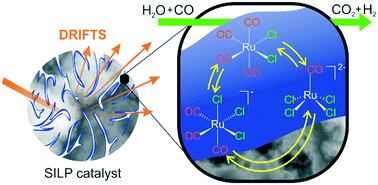当前位置:
X-MOL 学术
›
Catal. Sci. Technol.
›
论文详情
Our official English website, www.x-mol.net, welcomes your
feedback! (Note: you will need to create a separate account there.)
Dynamic equilibria in supported ionic liquid phase (SILP) catalysis: in situ IR spectroscopy identifies [Ru(CO)xCly]n species in water gas shift catalysis†
Catalysis Science & Technology ( IF 4.4 ) Pub Date : 2017-11-28 00:00:00 , DOI: 10.1039/c7cy02199b Tanja Bauer 1, 2, 3, 4 , Robert Stepic 2, 4, 5, 6, 7 , Patrick Wolf 2, 3, 4, 8 , Fabian Kollhoff 1, 2, 3, 4 , Weronika Karawacka 1, 2, 3, 4 , Christian R. Wick 9, 10, 11 , Marco Haumann 2, 3, 4, 8 , Peter Wasserscheid 2, 3, 4, 8, 12 , David M. Smith 2, 9, 10, 11, 13 , Ana-Sunčana Smith 2, 4, 5, 6, 7 , Jörg Libuda 1, 2, 3, 4, 12
Catalysis Science & Technology ( IF 4.4 ) Pub Date : 2017-11-28 00:00:00 , DOI: 10.1039/c7cy02199b Tanja Bauer 1, 2, 3, 4 , Robert Stepic 2, 4, 5, 6, 7 , Patrick Wolf 2, 3, 4, 8 , Fabian Kollhoff 1, 2, 3, 4 , Weronika Karawacka 1, 2, 3, 4 , Christian R. Wick 9, 10, 11 , Marco Haumann 2, 3, 4, 8 , Peter Wasserscheid 2, 3, 4, 8, 12 , David M. Smith 2, 9, 10, 11, 13 , Ana-Sunčana Smith 2, 4, 5, 6, 7 , Jörg Libuda 1, 2, 3, 4, 12
Affiliation

|
Ru-based supported ionic liquid phase (SILP) systems efficiently catalyze the low-temperature water-gas shift reaction (WGSR). While previous studies suggest that Ru-carbonyl species play an important role in the mechanism, detailed knowledge on the catalytically active species is still missing. To identify these carbonyl complexes, we apply in situ diffuse reflectance infrared Fourier transform spectroscopy (DRIFTS) in combination with density functional theory (DFT). Investigations of an as-prepared [Ru(CO)3Cl2]2/[C4C1C1Im]Cl/Al2O3 catalyst indicate splitting of the dimer induced by Cl−. Subsequently, an equilibrium between several [Ru(CO)xCly]n species is established, in which the IL serves as an effectively infinite Cl− reservoir. We find that the major species in the system freshly-prepared from [Ru(CO)3Cl2]2 is indeed [Ru(CO)3Cl3]−. A smaller amount of [Ru(CO)2Cl3]− and chloride-rich species [Ru(CO)2Cl4]2− or [RuCOCl4]2− are also found in the SILP. Similar Ru-carbonyl species are observed during carbonylation of RuCl3/[C4C1C1Im]Cl/Al2O3, another potential WGSR catalyst. The response of [Ru(CO)3Cl2]2/[C4C1C1Im]Cl/Al2O3 to heating and/or CO dosing was probed in situ and the results confirm the presence of the equilibrium proposed above.
中文翻译:

负载型离子液相(SILP)催化中的动态平衡:原位红外光谱法可确定水煤气变换催化中的[Ru(CO)x Cl y ] n物种†
钌基负载离子液体(SILP)系统有效催化低温水煤气变换反应(WGSR)。尽管先前的研究表明,Ru-羰基物质在该机理中起着重要作用,但仍缺乏有关催化活性物质的详细知识。为了鉴定这些羰基配合物,我们结合密度泛函理论(DFT)应用原位漫反射红外傅里叶变换光谱法(DRIFTS)。一个如此制备的[Ru(CO)的调查3氯2 ] 2 / [C 4 Ç 1 c ^ 1 IM] CL /的Al 2 ö 3催化剂指示由氯诱导的二聚体的分裂-。随后,之间的平衡几个的[Ru(CO)X氯ÿ ] Ñ物种被建立,其中所述IL用作有效无限氯-储器。我们发现,由[Ru(CO)3 Cl 2 ] 2新鲜制备的系统中的主要种类确实是[Ru(CO)3 Cl 3 ] -。少量的[Ru(CO)2 Cl 3 ] -和富含氯化物的物质[Ru(CO)2 Cl 4 ] 2-或[RuCOCl 4 ] 2-也可以在SILP中找到。在另一种潜在的WGSR催化剂RuCl 3 / [C 4 C 1 C 1 Im] Cl / Al 2 O 3的羰基化过程中观察到类似的Ru-羰基物质。在原位探测了[Ru(CO)3 Cl 2 ] 2 / [C 4 C 1 C 1 Im] Cl / Al 2 O 3对加热和/或CO加料的响应,结果证实了所提出的平衡的存在以上。
更新日期:2017-11-28
中文翻译:

负载型离子液相(SILP)催化中的动态平衡:原位红外光谱法可确定水煤气变换催化中的[Ru(CO)x Cl y ] n物种†
钌基负载离子液体(SILP)系统有效催化低温水煤气变换反应(WGSR)。尽管先前的研究表明,Ru-羰基物质在该机理中起着重要作用,但仍缺乏有关催化活性物质的详细知识。为了鉴定这些羰基配合物,我们结合密度泛函理论(DFT)应用原位漫反射红外傅里叶变换光谱法(DRIFTS)。一个如此制备的[Ru(CO)的调查3氯2 ] 2 / [C 4 Ç 1 c ^ 1 IM] CL /的Al 2 ö 3催化剂指示由氯诱导的二聚体的分裂-。随后,之间的平衡几个的[Ru(CO)X氯ÿ ] Ñ物种被建立,其中所述IL用作有效无限氯-储器。我们发现,由[Ru(CO)3 Cl 2 ] 2新鲜制备的系统中的主要种类确实是[Ru(CO)3 Cl 3 ] -。少量的[Ru(CO)2 Cl 3 ] -和富含氯化物的物质[Ru(CO)2 Cl 4 ] 2-或[RuCOCl 4 ] 2-也可以在SILP中找到。在另一种潜在的WGSR催化剂RuCl 3 / [C 4 C 1 C 1 Im] Cl / Al 2 O 3的羰基化过程中观察到类似的Ru-羰基物质。在原位探测了[Ru(CO)3 Cl 2 ] 2 / [C 4 C 1 C 1 Im] Cl / Al 2 O 3对加热和/或CO加料的响应,结果证实了所提出的平衡的存在以上。











































 京公网安备 11010802027423号
京公网安备 11010802027423号